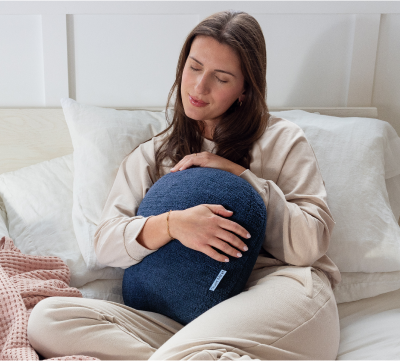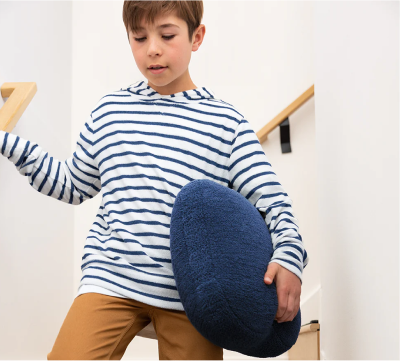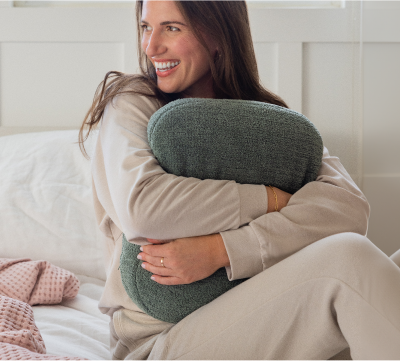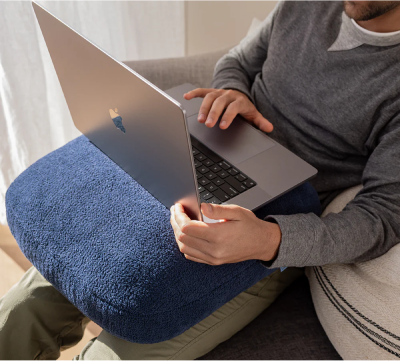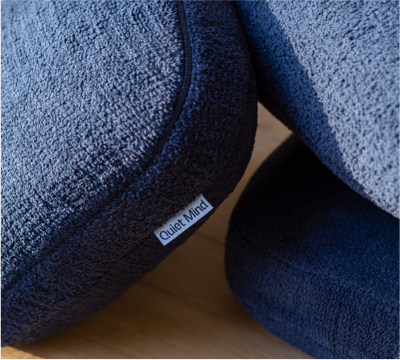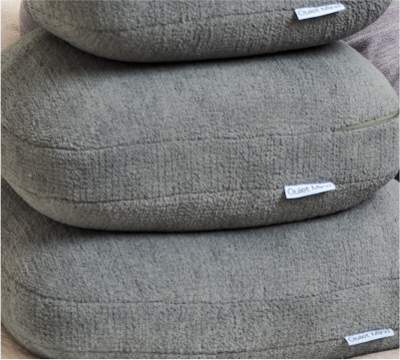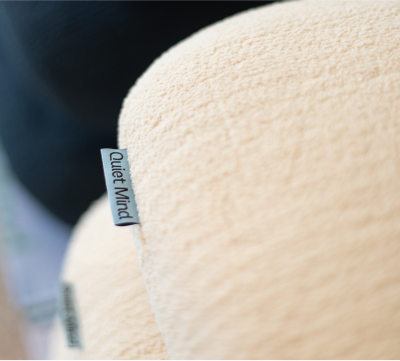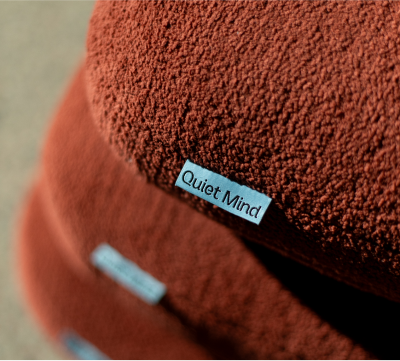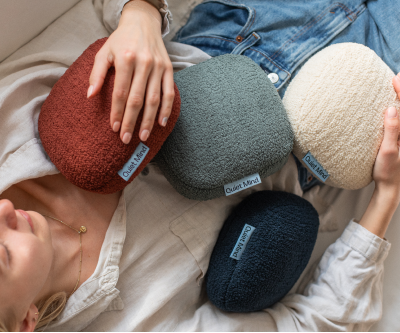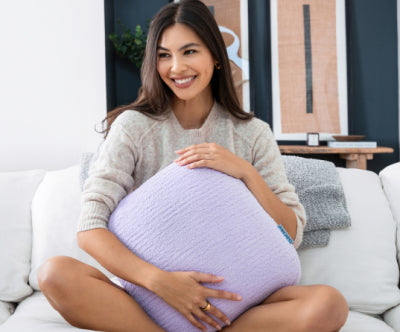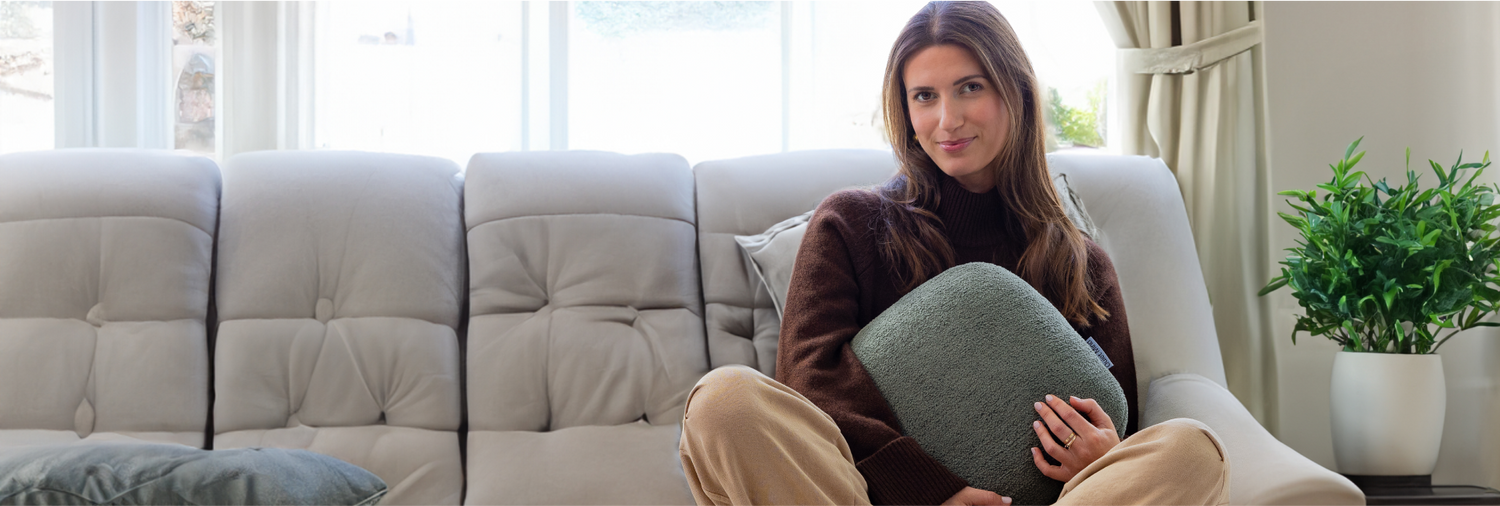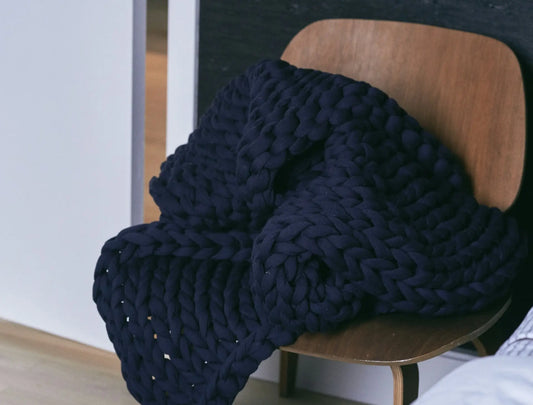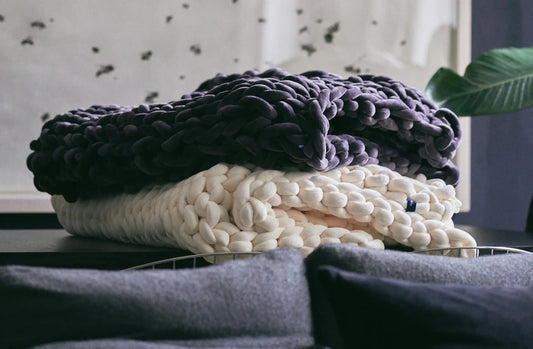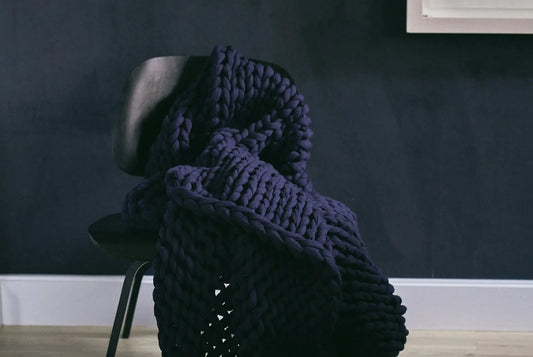Not every path to wellness begins in a prescription pad. Sometimes, it starts with a quiet shift in how we support the body; like the gentle pressure provided by a weighted blanket.
Weighted blankets have become increasingly common in both home and clinical settings. More people are turning to them as a natural way to reduce anxiety, improve sleep habits, and regulate the nervous system.
Whether filled with glass beads or poly pellets, these blankets deliver steady, widespread pressure, an approach known as deep pressure stimulation.
This guide explores what doctors say about weighted blankets, their safety and effectiveness, and how weighted blankets affect both the body and mind. We look at what recent studies suggest about their impact on sleep and daily wellbeing.
Are Weighted Blankets Doctor-Approved for Sleep and Anxiety?
More physicians are acknowledging weighted blankets as a gentle, non-pharmacological intervention, especially for those navigating anxiety, insomnia, ADHD, or sensory overload. The purpose of a weighted blanket is to offer steady, calming input to the body that helps regulate the nervous system and promote a sense of safety.
How Weighted Blankets Influence the Nervous System
The effect of weighted blankets on the nervous system is rooted in deep pressure stimulation (DPS). This technique involves the widespread pressure delivered across the body, similar to a hug or firm touch, which helps activate the parasympathetic nervous system.
When activated, this system may:
-
Reduce stress by lowering cortisol.
-
Increase serotonin and melatonin (which support mood and sleep).
-
Encourage a state of calm and stillness.
-
Improve the transition into deeper sleep stages.
The weight, often created by glass bead filling, creates a consistent tactile input. This sensation can promote grounding and relaxation, especially helpful for people with sensory overload, ADHD, or anxiety.
The pressure of a weighted blanket isn’t just soothing, it sends a message to the brain: you’re safe to rest now.
Clinical Use for Insomnia, Anxiety, and ADHD
In therapeutic settings, the use of weighted blankets is gaining momentum as part of sensory-informed care.
-
Insomnia: Studies and clinical feedback suggest that weighted blankets may help reduce the time it takes to fall asleep, increase total sleep time, and decrease nighttime wakefulness. They also found that weighted blankets improved sleep continuity in individuals with chronic insomnia.
-
Anxiety: The pressure provided by a weighted blanket may help reduce anxiety and create a sense of containment during high-stress moments. For individuals with generalized anxiety, this sensation can offer emotional regulation support.
-
ADHD and Sleeping Difficulties: Many occupational therapists recommend weighted blankets for children with ADHD and sleeping challenges. The consistent input can reduce restlessness and improve focus before bed. Adults with attention deficit hyperactivity may also experience improved wind-down routines and reduced nighttime overactivity.
For children with autism spectrum disorders or sensory sensitivities, weighted blankets may play a supportive role in therapy. They are often used to help improve emotional regulation and build healthier sleep habits.
What Medical Research Says About Weighted Blankets
The science is still emerging, but current findings support what many already sense: pressure can calm.
Studies on Deep Pressure Stimulation and Cortisol Reduction
Several peer-reviewed studies have linked deep pressure stimulation (DPS), the mechanism behind weighted blankets with measurable physiological effects related to sleep, stress, and emotional regulation:
-
A randomized controlled trial published in the Journal of Clinical Sleep Medicine found that adults with insomnia and psychiatric conditions experienced significant improvements in sleep maintenance, reduced daytime fatigue, and increased overall sleep satisfaction after four weeks of using a weighted chain blanket.
-
A review of multiple studies on massage therapy, another form of DPS, reported an average 31% reduction in cortisol, the body’s primary stress hormone, following treatment. While not specific to blankets, this supports the broader impact of sustained pressure on physiological stress responses.
-
Research in the American Journal of Occupational Therapy found that deep pressure input through a weighted blanket may help reduce anxiety, modulate arousal, and support emotional regulation in neurodivergent individuals, including those with autism and sensory sensitivities.
Evidence Supporting Use in Mental Health and Sleep Disorders
Weighted blankets are not a cure, but evidence suggests they may serve as a complementary support for individuals navigating anxiety, sleep issues, trauma recovery, and sensory sensitivities.
Based on available clinical research and therapist-guided use, weighted blankets have shown potential benefits in the following areas:
-
Generalized Anxiety and Stress: A crossover study published in Occupational Therapy in Mental Health (Chen et al., 2013) found that adults who used a 30-lb weighted blanket during a stress-inducing task reported significantly lower anxiety (as measured by STAI scores), along with decreases in electrodermal activity and pulse rate, markers of sympathetic arousal.
-
Post-Traumatic Stress Disorder (PTSD): While large-scale trials are limited, clinicians and trauma-informed therapists often incorporate weighted blankets into sensory regulation strategies for people with PTSD. The mechanism providing a sense of safety and containment, is supported by DPS theory, though more targeted research is needed.
-
Insomnia and Circadian Rhythm Disruption: The randomized controlled trial by Ekholm et al. (2020) noted earlier also documented improved sleep maintenance and overall restfulness in participants with both insomnia and mental health diagnoses. Weighted blankets helped reduce nighttime movement and arousal, leading to more consolidated sleep.
-
Dementia-Related Agitation: A study found that older adults with dementia experienced reduced restlessness and agitation during daytime hours when using lap-weighted sensory devices. Though small in scale, the findings support further research into non-pharmacological interventions for behavioral symptoms of dementia.
-
Pediatric sensory processing and ADHD: A crossover trial in children with autism found no statistical difference in sleep outcomes but did note parent-reported improvements in settling and bedtime routines.
Weighted pillows may serve as an easier, daily-use complement in many of these cases. For example, PTSD patients may prefer a pillow for grounding during the day, while still using a blanket at night.
What Do Psychiatrists and Therapists Say About Weighted Blankets?
Psychiatrists, therapists, and occupational therapists often use weighted blankets as a supportive strategy, especially in trauma-informed, sensory-focused, or pediatric therapy.
Use in Sensory Processing, Autism, and PTSD Therapy
The widespread pressure delivered by a weighted blanket can help regulate sensory input and reduce the physiological signs of hyperarousal. This may be particularly helpful for individuals with:
-
Autism spectrum disorder.
-
Sensory processing disorder.
-
PTSD or developmental trauma.
For children and adults with attention or emotional regulation difficulties, a weighted blanket may help the body feel anchored, promoting stillness, safety, and calm.
|
Therapeutic Area |
Primary Benefit |
|
Sensory Processing |
Calms overstimulation, encourages regulation |
|
Autism Spectrum |
May help emotional balance and reduce outbursts |
|
PTSD and Trauma Recovery |
Soothes hyperarousal, builds a sense of containment |
Emotional Regulation and Daily Use
Therapists emphasize that comfort is personal. Some people prefer lighter blankets for daytime grounding, while others respond well to the firm, steady weight of a 15-pound blanket for nighttime use.
Using a weighted blanket properly means paying attention to your body’s cues and matching the blanket to your size, comfort level, and needs. Most weighted blankets range from 5 to 30 pounds, and should never feel restrictive, just supportive.
The goal isn’t to restrict, it’s to provide enough pressure to reduce anxiety and support a calm, focused state.
Weighted blankets are best viewed as part of a broader toolbox for managing mental health, not a standalone solution.
In combination with therapy, mindfulness, or cognitive-behavioral strategies, they may deepen the body’s sense of rest and regulation.
Are Weighted Blankets Recommended by Sleep Specialists?
Sleep specialists increasingly view the use of weighted blankets as a supportive addition to behavioral sleep strategies, especially for people with chronic insomnia, disrupted sleep-wake cycles, or stress-related sleep problems.
How They Fit Into Holistic Sleep Care
Weighted blankets may help reduce bedtime anxiety, encourage stillness, and promote a smoother transition into sleep by calming the nervous system. Doctors and sleep specialists often say that weighted blankets can be especially supportive for people with ADHD or sleep disorders, as they may reduce nighttime overstimulation and help signal the body to wind down.
Weighted blankets on sleep have been shown to:
-
Support deeper sleep by encouraging physical relaxation.
-
Help anchor the body, minimizing tossing and turning.
-
Complement other techniques like breathwork, light regulation, or bedtime routines.
Though not a primary treatment, the effectiveness of weighted blankets is most evident when integrated into a consistent and calming sleep environment.
They may help people establish healthier sleep habits and build trust in their ability to achieve a good night’s rest without relying solely on pharmaceutical options.
When Sleep Doctors Recommend Caution
While many people may benefit, sleep doctors do highlight important safety considerations. A weighted blanket may not be suitable for:
-
Individuals with sleep apnea, where added weight could restrict airflow.
-
People with asthma or respiratory sensitivity.
-
Those with circulatory issues such as poor blood flow or clotting disorders.
-
Anyone with limited mobility or muscle weakness who cannot remove the blanket independently.
Additionally, children under two should never use a weighted blanket due to the risk of suffocation. Even older children should be supervised and fitted with an appropriate weight based on their body size.
Medical consultation is especially important if a person has any underlying condition affecting breathing, movement, or temperature regulation.
Can Doctors Prescribe or Recommend Weighted Blankets?
Though not typically written as formal prescriptions, doctors and therapists may recommend weighted blankets as part of a care plan.
Medical and Occupational Therapy Applications
Occupational therapists frequently incorporate weighted blankets into treatment for children with:
-
Autism
-
ADHD
-
Sensory integration challenges
In some cases, insurance may cover a weighted blanket when prescribed by a medical professional for therapeutic use, particularly in pediatric or neurodivergent care.
Pediatric and Geriatric Considerations
Doctors working with children often use weighted blankets under supervision. Weight must be proportionate and closely monitored.
For older adults, especially those with anxiety, dementia, or sleep disruption, weighted blankets may offer comfort. But clinicians evaluate based on:
-
Mobility
-
Cardiopulmonary health
-
Skin sensitivity
The approach is always personalized and cautious.
When Do Doctors Warn Against Using Weighted Blankets?
Although many people find comfort in the use of weighted blankets, they are not suitable for everyone.
Doctors are careful to note certain contraindications, especially when physical safety or breathing capacity is compromised.
Health Conditions That Require Caution
A weighted blanket may not be advised for individuals with:
-
Sleep apnea or chronic breathing disorders.
-
Circulatory problems (e.g., clotting disorders or poor circulation).
-
Limited mobility or neuromuscular conditions.
-
Younger children under 2 years old, due to the risk of suffocation.
In these cases, the widespread pressure delivered by a weighted blanket could create discomfort or safety issues. Alternatives, such as a weighted lap pad or pillow, may offer similar sensory benefits without full-body weight.
General Safety Guidelines
Doctors and therapists emphasize the following safety principles:
-
Follow the 10% rule: Choose a weight that’s around 10% of the user’s body weight.
-
Ensure independent removal: The user must be able to adjust or remove the blanket on their own.
-
Use breathable materials: Especially important for overnight use or warmer climates.
-
Start slow: Begin with short sessions, such as 15–30 minutes, and observe the body's response.
When in doubt, trying a weighted blanket under professional guidance is the best approach.
The Everyday Alternative: Weighted Pillows
At Quiet Mind, we recognize that healing doesn’t always start with a prescription, it often begins with how we care for our nervous system. The growing interest in tools like weighted blankets reflects a deeper shift toward body-based support for anxiety, sleep, and sensory regulation.
One of our favorite tools is the Quiet Mind weighted pillow. Designed for versatile use across the chest, lap, or shoulders, it offers the same grounding comfort found in larger blankets, without the bulk. Unlike a blanket, it does not overheat, and unlike a lap pad, it provides enough weight for true relaxation.
Weighted Blankets vs. Weighted Pillows: Key Differences
While weighted blankets have strong clinical support, they also come with limitations:
-
Bulkiness: Difficult to transport or use outside the bedroom.
-
Overheating: Some find them too warm during extended use.
-
Expense: High-quality blankets can be costly.
-
Full-body coverage: Pressure is not always needed everywhere.
Weighted pillows solve many of these issues:
-
Portable: Easy to carry, use in bed, on the couch, or at work.
-
Targeted: Apply pressure exactly where you need it; lap, chest, or shoulders.
-
Affordable: Lower cost than most blankets.
-
Everyday use: Suitable for both daytime stress relief and nighttime relaxation.
Learn more about how Quiet Mind Weighted Pillows help with anxiety and sleep.
About Quiet Mind
At Quiet Mind, we recognize that healing doesn’t always start with a prescription, it often begins with how we care for our nervous system.
The growing interest in tools like weighted blankets reflects a deeper shift toward body-based support for anxiety, sleep, and sensory regulation.
Our mission is to help people explore these options with clarity, safety, and compassion, especially those navigating ADHD, stress, or sleep challenges.
One of our favorite tools is the Quiet Mind weighted pillow. Designed for versatile use across the chest, lap, or shoulders, it offers the same grounding comfort found in larger blankets, without the bulk.
Frequently Asked Questions
Do weighted blankets help with anxiety?
Yes. Deep pressure stimulation has been shown to lower cortisol and promote feelings of calm and security.
Are weighted blankets used for children with autism or ADHD?
Yes. Occupational therapists often recommend them to help regulate sensory input and support better focus and sleep.
What weight is best for a weighted blanket?
The general guideline is 10% of your body weight. Lighter options may be better for side sleepers or those with joint sensitivity.
Can doctors recommend or prescribe weighted blankets?
They may recommend them as part of therapeutic care, especially for anxiety, sensory needs, or sleep support. In some cases, insurance may provide coverage.
Are there risks associated with weighted blankets?
Yes, especially for children under two or individuals with certain medical conditions. Always consult your physician if unsure.
